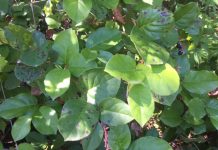By Kristine Lowder
![]() It’s a perfect time to “stop and smell the roses” at the Burton C. Ross Memorial Rose Garden in Hoquiam.
It’s a perfect time to “stop and smell the roses” at the Burton C. Ross Memorial Rose Garden in Hoquiam.
Located on the grounds of the Polson Museum on Riverside Avenue in Hoquiam, the garden’s iridescent blooms have a story all their own. Chapters include the Grays Harbor Rose Society, community involvement, volunteerism, and a Civil War monument.
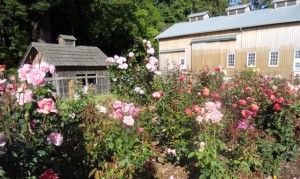
The Burton C. Ross Memorial Garden was planted in 1978 by members of the Grays Harbor Rose Society. Fourteen members donned rain gear and shovels and “labored in a downpour of rain such as only Grays Harbor residents can understand,” writes GHRS member Haidee Ross Douglas in 1980. Ross-Douglas continues, “… when they had finished that day, the first 75 roses had been planted in the bed to be named the Burton C. Ross Memorial Rose Garden –a tribute to a deceased Hoquiam member.”
The “deceased Hoquiam member” was Haidee’s husband, Burton C. Ross. The garden bears his name. Ross’s family contributed some of his own award-winning specimens for the garden.
Although the Society itself is now inactive, the garden is still tended by Society volunteers according to Grays Harbor Rose Society member and rosarian Helen Peters of Iron Springs, WA. Polson Museum Director John Larson says, “The ladies and men who come here to maintain the garden make it beautiful. They make it shine and they make us shine because of it. We love it and the community loves it.”
The garden itself is rooted in community involvement.
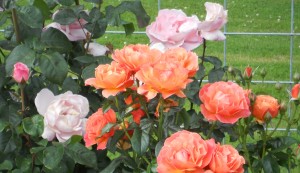
The Polson Museum Board of Directors granted permission for the use of the land located on the museum grounds. The City of Hoquiam delivered railroad ties to form the elevated bed and “a good covering of bark.” Friend & Rikalo, a local contracting firm, provided topsoil and sandy loam. Marshalls Pet & Garden Supplies provided peat moss and bone meal for transplanting procedures. A natural slab of cedar was donated by Grays Harbor College. The inscription on the sign identifying the garden was carved and burned by GHC Carpentry students.
“The garden has been featured on garden tours and has been very well received. It’s very valuable to the museum itself,” says Maren Buhler, Polson Museum secretary. Buhler says she often looks out her museum office window and sees people wandering through the garden enjoying the blooms, especially during sunny, summer days.
And there are plenty of floral beauties to enjoy. According to Peters, 160 rose bushes now grace the garden. The collection includes floribunda, miniature and climbing roses miniature roses and mostly hybrid teas. (Hybrid teas are the oldest group classified as a modern garden rose. Hybrid tea flowers are well-formed with large, high-centered buds, supported by long, straight and upright stems. They are the world’s most popular type of rose.)
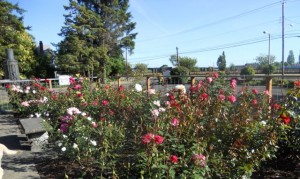
The garden itself has “out-lived” the Grays Harbor Rose Society in some respects. “It sort of ran down,” Peters says of the Society. “The president moved to Spokane and died.” Other members moved or passed away. But that hasn’t stopped those dedicated to cultivating a legacy of blooms and beauty for the Ross garden.
Explains Peters, “I’ve enlisted a few gals – six or seven – master gardeners to take care of it (the garden).” Volunteers come from Ocean Shores, Westport, Cosmopolis and Hoquiam to tend the floral beauties. Peters writes, “I love working here! It is so satisfactory to see the roses bloom so well. The Ross Rose Garden is in a most serendipitous spot!”
Besides the lovingly tended blooms, the Burton C. Ross Memorial Garden includes a unique historical feature: a sun dial monument. Peters recalls, “After the Rose Society was gone, John Larson (of the Polson Museum), asked us if we would be willing to put in the sun dial. We agreed, so the Polson Museum and the city put down the paved path in the middle for the timepiece.”
Dedicated in 1929, the sun dial was originally placed in an unnamed triangle park at “K” and Emerson Streets in Hoquiam by the Daughters of Union Veterans of the Civil War. Peters explains that the iconic dial was being vandalized and the original sun dial stolen. The sun dial was moved to its current site at the east end of the enclosed garden and re-dedicated in 1999.
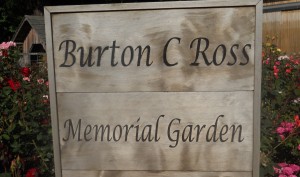
“(The garden) is a nice little getaway, with its sun dial, benches and roses,” reiterates Larson. “It’s a wonderful place to stop and enjoy the flowers. Just last week I was talking to some people who came to just sit here (in the garden) and de-stress from the week. There’s a lot of color and it’s just starting to come out.” Larson notes that a new surrounding fence was put up around the garden recently “to keep the deer at bay.” He says future plans include adding a second gate to the back of the garden that will lead to the museum’s Railroad Camp.
Peters says of the garden, “It’s very popular. People like to have weddings there.” She also noted that the Burton C. Ross Memorial Rose Garden is a popular destination for lovers of beauty, both local and distant, saying, “It has become quite a tourist attraction!”
Larson concurs. “What people go to the garden to experience is pretty magical. People who love beauty and floral things are drawn to the place. We have locals and tourists alike who stop to enjoy the sights and smells of the rose garden.”
And enjoy it they do, especially when everything’s comin’ up roses in this colorful little corner of Hoquiam.
The Burton C. Ross Memorial Garden is located just off the street on the grounds of the Polson Museum at 1611 Riverside Avenue in Hoquiam. For more information on the museum, visit the Polson Museum online or call 360-533-5862.
The Polson Museum is open Wednesday through Saturday from 11:00 a.m. to 4:00 p.m. and Sunday from 12:00 to 4:00 p.m. The museum is closed Monday and Tuesday and major national holidays. Family admission is $10. Adults are $4. Students are $2 and under 12 is $1.
The garden is always open.


























